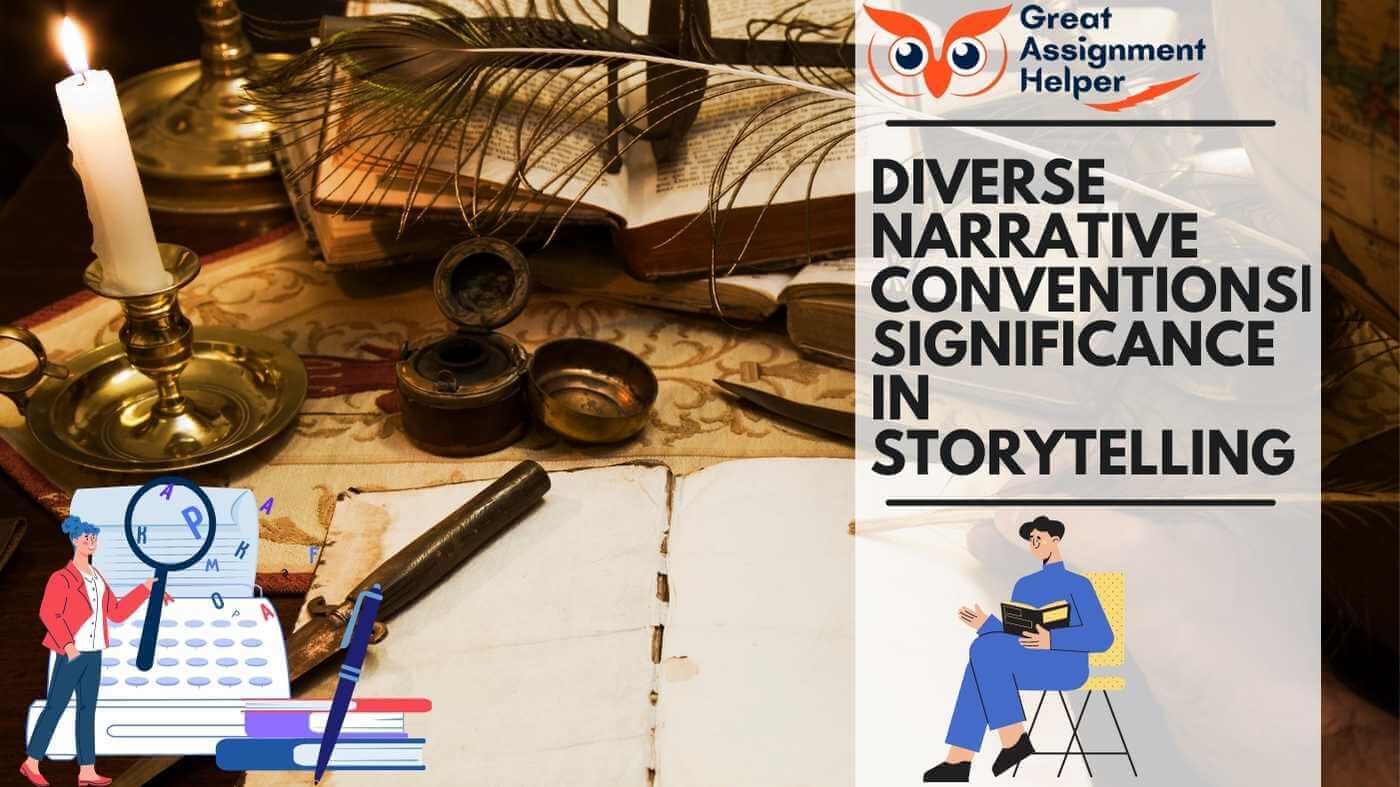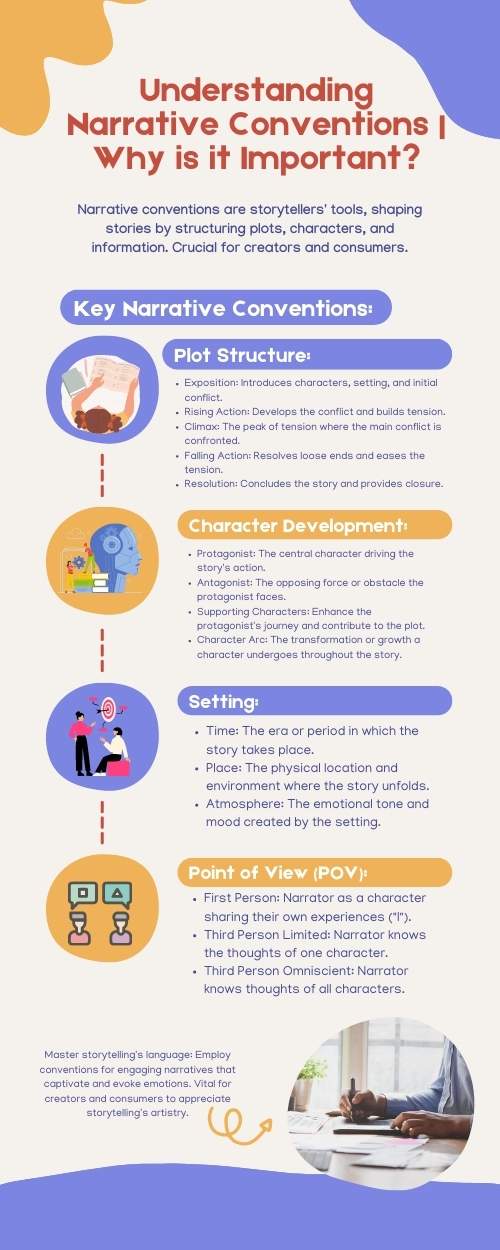
Welcome to our blog post on the significance of diverse narrative conventions in storytelling. In this essay, we will explore how understanding and utilizing various narrative techniques can enhance the overall impact of a story. We'll also discuss the role that essay help and English assignment help play in assisting college students with their writing tasks. So, whether you're looking for inspiration for your next essay or need assistance with your English assignments, this blog is here to provide valuable insights and guidance. Let's dive into the fascinating world of narrative conventions!
Listen To This Blog
Understanding Narrative Conventions| Why is it Important

Narrative conventions are essential elements in storytelling that shape the structure and flow of a narrative. These conventions include plot, character development, point of view, and setting. Understanding these conventions is crucial for successful academic writing as it helps students create cohesive and engaging essays.
In English assignments, utilizing diverse narrative conventions can greatly enhance the quality of coursework. Incorporating descriptive language techniques and exploring different perspectives can elevate an essay from average to exceptional. By employing these conventions effectively, students have the potential to achieve top grades while maintaining confidentiality in their writing process.
Definition of Narrative Conventions
Characterization, point of view, and setting are essential narrative conventions in storytelling. Characterization involves the creation and development of characters through descriptive details and actions, allowing readers to connect with them on a deeper level. Point of view determines whose perspective the story is told from, influencing how information is presented and interpreted. Setting establishes the time, place, and environment in which the story unfolds, creating a backdrop that enhances mood and atmosphere. Understanding these narrative conventions enables writers to craft compelling stories that engage readers.
Mastering narrative conventions such as characterization, point of view, and setting can significantly impact grades in English literature assignments. Effective use of descriptive language brings depth to analysis while carefully choosing perspectives ensures clarity in presenting arguments. Skillful utilization of setting enhances the overall impact by immersing readers into the world being portrayed.
In academic writing assignments such as essays or coursework focused on English literature, mastering narrative conventions like characterization, point of view, and setting can significantly impact grades. Effective use of descriptive language in character development brings depth to analysis while demonstrating strong writing skills. Carefully choosing point-of-view perspectives ensures clarity in presenting arguments or interpretations. Skillful utilization of setting enhances the overall impact of descriptions by immersing readers into the world being portrayed. Confidentiality should always be maintained when seeking essay help or English assignment assistance for academic purposes
Types of Narrative Conventions
Flashback, foreshadowing, and symbolism are types of narrative conventions commonly used in storytelling. These techniques add depth and complexity to a narrative, engaging the reader and enhancing their understanding of the story.
- Flashback: A narrative device that interrupts the chronological order of events to present an earlier scene or memory. It provides background information or reveals important details that help shape the plot.
- Foreshadowing: Foreshadowing entails dropping subtle hints or clues within a narrative to imply forthcoming events. This technique instills a sense of expectation and progressively heightens the suspense surrounding what lies ahead.
- Symbolism: Utilizing objects, characters, or actions as symbolic representations of abstract ideas or concepts is a literary device that enriches narratives. This technique not only adds depth and complexity to the storytelling but also invites readers to explore themes and messages on a more profound level, encouraging a richer and more immersive reading experience.
These narrative conventions are essential tools for writers seeking higher grades on their assignments by showcasing advanced storytelling techniques while creating a more descriptive reading experience for their audience.
Importance of Narrative Conventions in Storytelling
Engages the reader emotionally: Narrative conventions play a crucial role in storytelling by engaging the reader on an emotional level. Through compelling characters, vivid descriptions, and well-crafted dialogue, these conventions create a connection between the reader and the story. This emotional engagement enhances the overall reading experience and makes it more memorable.
Enhances plot development: Narrative conventions serve as building blocks for plot development. They provide structure, pacing, and tension to keep readers hooked throughout the story. Whether it's foreshadowing events, using flashbacks or employing suspenseful cliffhangers, these techniques keep readers eagerly turning pages to find out what happens next.
Provides deeper meaning and interpretation: Narrative conventions allow authors to convey deeper meanings in their stories. Symbolism, allegory, motifs - all of these elements add layers of complexity that invite readers to analyze and interpret the text beyond its surface level. By exploring themes such as love, power dynamics or society through narrative devices like irony or dramatic irony writers can provoke thought-provoking discussions among readers.
Exploring Diverse Narrative Conventions
Differences in narrative conventions across cultures provide a fascinating insight into the diverse ways stories are told. From non-linear structures to oral traditions, each culture brings its unique approach to storytelling, enriching the global narrative landscape.
The impact of diverse narrative conventions on the reader or viewer experience cannot be underestimated. These distinct storytelling techniques have the power to evoke different emotions, challenge traditional perspectives, and offer fresh insights into familiar narratives. By embracing these diverse conventions, storytellers can create more engaging and culturally relevant experiences for their audiences.
Examples of diverse narrative conventions in literature and film abound, showcasing the range of possibilities for storytelling. From magical realism in Latin American literature to experimental narratives like stream-of-consciousness writing or nonlinear plotlines found in postmodernist works, these unconventional approaches push boundaries and challenge readers' preconceived notions about storytelling.
By exploring diverse narrative conventions across cultures, we can unlock new dimensions of storytelling that transcend geographical boundaries and foster a deeper understanding between people from different backgrounds.
Differences in Narrative Conventions across Cultures
Use of oral traditions in indigenous cultures has a profound impact on narrative conventions. These cultures prioritize storytelling as a way to preserve history, pass down cultural values, and foster community connections. The oral tradition often incorporates techniques such as repetition, rhythmic language, and communal participation, creating an immersive and interactive storytelling experience.
Cultural beliefs and values significantly shape the techniques used in storytelling across different societies. For example, in some cultures where collectivism is emphasized, narratives focus more on communal themes and the interconnectedness of characters. On the other hand, individualistic societies may prioritize personal growth or achievement within their narratives. This influence can be seen in character development, plot choices, and even moral lessons conveyed.
Narrative structures and plot developments vary greatly across cultures due to diverse storytelling traditions. Some narratives follow linear structures with clear beginning-middle-end progressions while others embrace non-linear approaches that weave together multiple timelines or perspectives. Similarly, plot developments can differ based on cultural preferences for suspenseful twists or open-ended conclusions that encourage reflection. These variations highlight the richness of global storytelling traditions.
Impact of Diverse Narrative Conventions on Reader/Viewer Experience
Enhanced engagement is achieved through the use of unique storytelling methods, allowing readers/viewers to experience narratives in fresh and unexpected ways. By breaking away from traditional narrative conventions, such as non-linear timelines or unreliable narrators, writers and directors can captivate audiences by challenging their expectations and delivering a more immersive experience.
- Non-linear timelines
- Unreliable narrators
Cultural immersion and understanding are fostered through diverse narratives that explore different perspectives and experiences. With the inclusion of characters from various backgrounds, cultures, or ethnicities, readers/viewers are given an opportunity to gain insight into unfamiliar worlds and develop empathy for characters with whom they may not have previously identified.
- Characters from diverse backgrounds
- Exploration of unfamiliar worlds
Narrative conventions greatly influence emotional connections between readers/viewers and fictional characters. The way a story is told – whether it emphasizes internal monologues or external actions – shapes our perception of characters' thoughts, motivations, fears, and desires. This connection allows us to empathize with them on a deeper level.
- Emphasis on internal monologues
- Depiction of thoughts/feelings
Examples of Diverse Narrative Conventions in Literature and Film
Magical realism in Latin American literature (e.g., Gabriel Garcia Marquez):
- Blending elements of the supernatural with everyday reality
- Challenging traditional notions of time and space
Rashomon effect:
- Multiple perspectives in Akira Kurosawa's films:
- Presenting contradictory accounts of the same event
- Exploring the subjectivity and unreliability of human perception
Stream-of-consciousness technique employed by authors like James Joyce:
- Replicating the continuous flow of thoughts, feelings, and sensations
- Offering insight into characters' inner worlds
These narrative conventions provide unique storytelling experiences by breaking conventional boundaries, inviting readers or viewers to question truth, explore alternative realities, and delve into complex psychological depths.
Enhancing Storytelling through Narrative Conventions
Narrative conventions play a vital role in enhancing storytelling by creating engaging characters. By utilizing techniques such as character development and well-crafted dialogue, writers can captivate readers and immerse them in the narrative. Through these conventions, authors are able to bring their characters to life and establish an expository connection between the audience and the story.
The use of narrative conventions also contributes to building suspense and surprise within a story. Employing techniques such as foreshadowing, plot twists, and dramatic irony allows writers to keep readers on the edge of their seats. By strategically incorporating these elements into their narratives, authors can create an atmosphere of anticipation that leaves audiences hungry for more.
In addition, narrative conventions serve as powerful tools for conveying themes and messages within storytelling. Symbolism, allegory, and motifs are examples of devices that enable writers to explore complex ideas through subtlety and depth. By intertwining these literary elements with the plotline or characterization, authors can communicate profound insights while adding layers of meaning to their stories.
In conclusion,
Enhancing Storytelling through Narrative Conventions is essential in captivating readers' attention by developing intriguing characters while keeping them engaged with suspenseful plots filled with surprises throughout its unfolding events; furthermore using symbolism helps convey intricate messages allowing deeper understanding alongside subtle thematic exploration.
Creating Engaging Characters through Narrative Conventions
Character development is a crucial aspect of storytelling, and narrative conventions offer effective techniques to create engaging characters. Through interior monologue, writers can delve into the thoughts and feelings of their characters, providing insight into their motivations and desires. Dialogue serves as a powerful tool to reveal personality traits, allowing readers to understand the character's values and beliefs through their interactions with others. Additionally, employing flashbacks deepens character backstory, offering glimpses into past experiences that shape who they are in the present.
By utilizing these narrative conventions effectively, writers have the opportunity to bring their characters to life on the page and captivate readers with compelling personalities and layered backgrounds.
Using Narrative Conventions to Create Suspense and Surprise
Building tension through foreshadowing is a powerful narrative convention that keeps readers on the edge of their seats. By dropping subtle hints and clues about future events, authors create an atmosphere of anticipation and uncertainty, building suspense with every turn of the page.
Implementing plot twists for unexpected outcomes adds another layer of excitement to storytelling. When readers think they have figured out what will happen next, a well-crafted twist can completely upend their expectations and leave them amazed. This element of surprise keeps them engaged and eager to discover what will happen next.
Utilizing cliffhangers at chapter or scene endings leaves readers wanting more, making it difficult for them to put the book down. By abruptly ending a section in a moment of high tension or just before a crucial revelation, authors create suspenseful breaks that propel readers forward in search of answers.
These narrative conventions are vital tools in creating suspense and surprise within stories. They not only captivate readers but also elevate the overall experience by keeping them hooked until the very end.
Utilizing Narrative Conventions to Convey Themes and Messages
Symbolism is a powerful tool in storytelling, allowing authors to convey deeper meanings and themes through the use of objects, actions, or characters. By imbuing these symbols with significance, writers can evoke emotions and provoke thought in their readers. Allegory is another narrative convention that enables authors to explore abstract concepts by using metaphorical representations. Through allegorical storytelling, complex ideas can be conveyed in a more accessible and engaging manner.
In order to effectively deliver themes and messages in literature, authors often employ the "show, don't tell" approach. Rather than explicitly stating the intended theme or message, they allow it to unfold organically through the actions and behaviors of their characters or events within the story itself. This technique encourages readers to actively interpret and engage with the text while experiencing a deeper connection with its underlying themes.
- Symbolism as a tool for conveying deeper meaning
- Allegory as a means of exploring abstract concepts
- 'Show, don't tell' approach in delivering themes
The Role of Essay Help and English Assignment Help
Essay help and English assignment help services play a crucial role in assisting college students with understanding and analyzing narrative conventions. These services provide valuable guidance on identifying various literary devices, plot structures, and character development techniques used in storytelling. By offering expert insights and analysis, essay help services enable students to gain a deeper understanding of diverse narrative conventions.
English assignment help not only enhances writing skills but also equips students with the ability to effectively utilize narrative conventions. Through personalized feedback and constructive criticism, these services empower students to craft compelling essays that incorporate appropriate narrative elements. By honing their writing abilities, English assignment help enables students to effectively convey their ideas while utilizing the power of storytelling.
In conclusion,
essay help and English assignment helper are invaluable resources for college students seeking assistance with understanding diverse narrative conventions. From analyzing literary devices to enhancing writing skills, these services play a crucial role in empowering students to navigate the complexities of storytelling successfully.
How Essay Help Services Assist with Understanding and Analyzing Narrative Conventions
Identifying the various narrative conventions used in literary works is a crucial aspect of understanding and analyzing them. Essay help services can assist college students in recognizing these conventions, such as point of view, structure, and characterization. By honing their skills in identifying these elements, students can gain deeper insights into the storytelling techniques employed by authors.
Analyzing the impact of narrative conventions on storytelling is another key area where essay help services prove beneficial. These services aid students in examining how specific narrative choices influence plot development and character arcs. Through this analysis, students can uncover thematic meanings conveyed by different narrative techniques and better appreciate their role in enhancing the overall storytelling experience.
Additionally, exploring common narrative techniques like flashback, foreshadowing, and symbolism is an essential part of comprehending literary works. Essay help services provide valuable guidance to college students in dissecting these techniques and uncovering their significance within the larger context of a story. By delving into these elements more deeply with professional assistance, students can strengthen their ability to interpret narratives effectively.
English Assignment Help: Enhancing Writing Skills to Effectively Utilize Narrative Conventions
Developing a strong thesis statement is crucial in guiding your essay's argument. A well-crafted thesis provides clarity and focus, allowing you to effectively convey your main ideas. Furthermore, improving paragraph structure and coherence enhances the overall organization of your essay. Each paragraph should have a clear topic sentence that supports your thesis, followed by supporting evidence and analysis. Lastly, using transitional words and phrases helps create smooth transitions between ideas, ensuring a seamless flow throughout your essay. By incorporating these strategies into your writing, you can enhance the effectiveness of narrative conventions in storytelling.
Tips for College Students Seeking Essay Help and English Assignment Help
When seeking assistance with essays, dissertations, research papers or assignments, it is crucial to communicate clear instructions. Clearly explain the specific areas and topics where you need help and provide relevant details about your assignment. This will ensure that the person assisting you understands exactly what you are looking for.
To receive targeted help on narrative conventions, ask specific questions about how they are used in storytelling. Rather than posing broad inquiries like, "What are some narrative conventions?" direct your attention toward specific aspects such as character development, plot structure, and point of view. This will enable you to receive more precise guidance tailored to your needs.
For independent learning, make use of online resources such as writing guides and grammar checkers. These tools can provide valuable insights into essay writing techniques and help improve your overall language skills. It is advisable that in case you find yourself in difficulty, then you may reach out to a reliable writing service in the form of greatassignmenthelper.com. The experts over their undertake requisite research, put in the hard work, create bespoke and unique content. After the content is created, proper proofreading, editing and vetting to ensure that you receive high quality work and a+ grades. Take advantage of their features to enhance your understanding and practice applying narrative conventions effectively in your own work.

